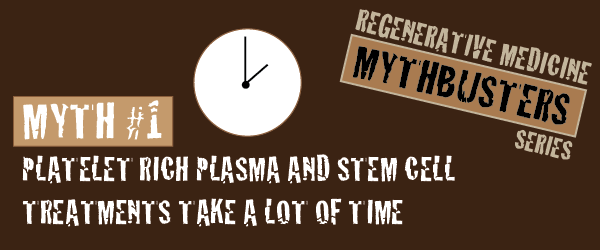In the veterinary hospital, a major component revolving around the integration of a new therapy is time. How long is the treatment going to take? How many personnel will need to be scheduled to administer the therapy? How long does the patient need to be under sedation (if needed)? How long does the patient need to be in recovery?
The old saying “time is money” certainly has its place in the veterinary hospital. If a procedure requires several technicians and takes numerous hours to perform for treating one patient, that may not be an efficient use of the hospital’s or technician’s time. In the early years of regenerative medicine, many of the therapies required numerous anesthetic episodes and several hours of both the technician’s and doctor’s time. The procedures required a dog to be anesthetized to collect the sample and then return in a separate hospital visit to be administered the therapy. The collection of the tissue and administration required the doctor to be scheduled for two surgical procedures as well as the attending technician(s). In total, the time to perform this therapy could easily approach 2 hours of doctor and technician time combined, which would then necessitate a higher fee for the single therapy to cover the overhead costs. For many customers, the combination of the numerous office visits and cost of the procedures would be prohibitive, making this therapy less appealing.
Today, these therapies have become extremely efficient only requiring a single office visit with processing and administration taking less than 30 minutes. For Platelet Rich Plasma (PRP) the process takes even less time (typically 15 minutes from start to finish) with most of the procedure being performed by the attending technician(s). The steps for processing PRP are quite simple, making it a therapy that can be easily cross-trained for the supporting staff. The doctor’s time is only required for the administration of the therapy, which takes less than 2-3 minutes (depending on the number of areas being injected). With this minimal time requirement, providing regenerative therapies can easily be scheduled in-between other procedures, exams or surgeries.
To hear a first-hand account of how the Companion Regenerative Therapies System benefited a general practice and their schedule:
Stay tuned for our next blog post where we “bust” another regenerative medicine myth!
Cats can be challenging to treat in most hospital settings – but not when it comes to laser therapy. The non-invasive approach and soothing application lend themselves to the fear-free practice. Oftentimes, a feline patient will actually start to purr, knead, and press into the treatment head attachment, showing relief and pleasure.
Typically, the feline patient will be more relaxed on an elevated position, possibly incorporating a semi-open bedding area. This can be as simple as the cat carrier with the top removed on an exam table. Or, it could be a series of small cat trees with platforms around the treatment room.
Creating a therapeutic setting also includes things such as natural/soft lighting, white noise, pheromone dispenser, etc. A thick fleece bedding is very comfortable, promotes kneading, and encourages the patient to ease into the treatment. Unless when dealing with a condition around the face, mouth, or ears, most cats actually tolerate laser-safe Doggles well and they seem to have a soothing/calming effect.
The laser operator may also choose to use distraction techniques, like placing catnip on a surface or object, or anything else smelly and tasty, like a dollop of LaxAire or baby food on a tongue depressor. Another distraction technique would be the operator starting by giving a neck massage prior to working on the painful tissues themselves.
Although feline patients can be challenging to work with, this is typically not a concern when dealing with laser therapy, the vast majority of these patients will habituate very quickly. The adept laser operator will consider some of the above techniques to minimize the patient’s stress and provide for a fear-free therapeutic treatment atmosphere.
Spinal cord injuries can have a devastating impact on a patient’s life. For the canine patient, spinal cord injuries are surprisingly common, accounting for approximately 2% of all cases that are presented to the veterinarian*. The most common forms of injuries arise from acute disc herniation, spinal trauma, fibrocartilaginous embolic myelopathy and chronic diseases including degenerative myelopathy and spinal stenosis. While the initial injury to the spine is a major concern, it’s the secondary effects of that trauma that have long lasting effects including impaired blood flow which can lead to “stroke-like” events.
Spinal tissue has poor regenerative properties, which can provide a challenge to the attending veterinarian when choosing a treatment program for their patient. Depending on the severity of the injury, some patients can make a significant recovery with a comprehensive rehabilitation program. Some patients, however, may remain unresponsive to physical rehabilitation and require further intervention. Below is an overview to a case study originally reported in Veterinary Practice News (February 2016) by David R. Mason, B. Vet. Med, DACVS, DECVS, of Las Vegas Veterinary Specialty Center. This case study focuses on a young, 5-year-old Labrador Retriever named Duncan with Fibrocartilaginous Embolic Myelopathy (FCE).
FCE is a condition in which a fragment of disc material is somehow forced into the spinal vasculature. This migration of disc material causes a “stroke-like” event, cutting off blood flow to the surrounding spinal tissue. This event can cause partial or complete paralysis to the patient. FCE is most commonly reported in large and giant breeds, but is also prevalent in sheep dogs and miniature schnauzers. The most common treatment protocol for patients with FCE is based around aggressive supportive care and physical therapy.
Duncan’s owners reported that he was in the back yard when he vocalized and then was found unable to move his back limbs. After undergoing a thorough evaluation at Las Vegas Veterinary Specialty Center (LVVSC), it was determined that Duncan was suffering from FCE. Subsequently, Duncan was enrolled in a 16-month rehabilitation program, but his condition did not improve and he remained non-ambulatory in his back limbs. Knowing that additional treatment options were limited for Duncan, Dr. Mason elected to treat Duncan with a combination of Platelet Rich Plasma (PRP) and Bone Marrow Aspirate Concentrate (BMAC). Duncan was treated with an epidural injection of PRP/BMAC solution which was produced using the Companion Regenerative Therapies System. After injection, Duncan recovered from anesthesia without incident and returned to his dedicated rehabilitation program.
By day 14, Duncan’s owners reported an increase in energy and after continuing his rehabilitation, Duncan is now able to take several steps without the assistance of a sling or cart. Although Duncan’s condition may not return fully to pre-injury form, this case provides a positive outlook to treating spinal conditions with regenerative medicine.
To read more about Duncan’s story, click here.
* https://cvm.ncsu.edu/research/labs/clinical-sciences/canine-spinal-cord-injury/




